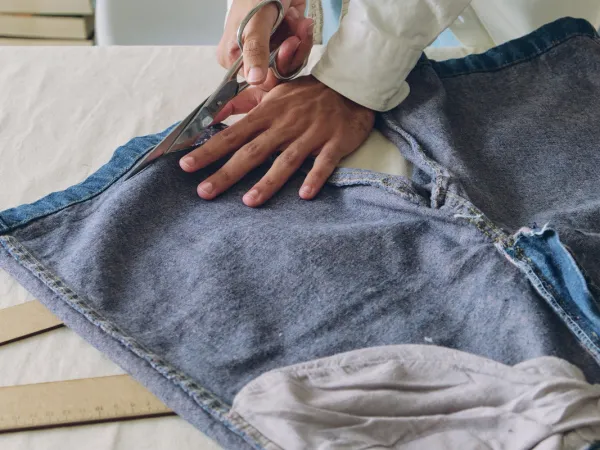The healthcare industry is important in society, and professionals in this field are responsible for the care and recovery of patients. In such an environment, professional attire holds great importance. This article aims to provide a comprehensive guide to the following contents:
- What are medical scrubs?
- Can use denim to make medical scrubs?
What is Medical Scrubs?
Medical scrubs are the special attire worn by professionals (including doctors, nurses, and other medical staff) in the hospital system while working. Originating in the 1940s, medical scrubs have seen significant evolution in terms of design and functionality. They are primarily worn in clinical and surgical settings to maintain hygiene and cleanliness.
- Purpose and Function of Medical Scrubs
Cleanliness and hygiene are one of the main goals of the healthcare industry. Medical scrubs serve this purpose by being easy to clean and providing a barrier between the wearer and potential contaminants. Moreover, medical scrubs help in promoting identification and professionalism within the healthcare facility, enabling patients and staff to easily recognize different roles and responsibilities. Additionally, medical scrubs are designed to offer comfort and functionality during long shifts and demanding tasks.
- Design and Features of Medical Scrubs
Medical scrubs can be made from various fabrics, and each of them has its performance characteristics. For instance, cotton medical scrubs provide breathability, while polyester blends offer durability and resistance to stains. Moreover, medical scrubs consist of basic elements such as a top and pants, featuring functional pockets and a relaxed fit for ease of movement. Accessory options, such as scrub caps and jackets, enhance practicality and personal protective measures.

- Medical Scrubs in Different Healthcare Settings
Medical scrubs find application in various healthcare settings, such as hospitals, medical facilities, dental clinics, laboratories, and veterinary clinics. Hospitals and medical facilities commonly use scrubs to create a standardized dress code, fostering a professional environment. Dental clinics and laboratories require scrubs to maintain sterility and minimize cross-contamination. In veterinary clinics and pet hospitals, medical scrubs offer protection against animal dander and provide an easily washable uniform.
- Caring for and Maintaining Medical Scrubs
Proper cleaning and maintenance of medical scrubs are essential for infection control and maintaining hygiene standards. Medical scrubs should be laundered using appropriate cleaning agents and techniques, emphasizing the importance of proper disinfection. Tips for extending the lifespan of medical scrubs, such as avoiding harsh chemicals and regular inspection for wear and tear, can help healthcare professionals get the most out of their uniforms. Additionally, considering ethical considerations in the disposal of medical scrubs, such as environmentally friendly practices, demonstrates a responsible approach.
Can Use Denim to Make Medical Scrubs?
Medical scrubs play a crucial role in the healthcare industry, fulfilling a variety of important functions. Their design, fabrics, and features are carefully chosen to meet the specific demands of the profession. Scrubs not only affect cleanliness and hygiene but also have psychological and societal impacts. As the healthcare industry continues to evolve, medical scrubs will likely maintain their significance while embracing new trends and innovations in medical attire. And here’s the question, can use denim to make medical scrubs? In the following paragraph, we are going to find out more.
Utility, comfort, and durability are the most important considerations when choosing the right fabric for medical scrubs. While denim is widely known for its durability and beauty in casual wear, its suitability as a medical scrub requires a thorough examination. The purpose of this article is to analyze denim as a potential fabric for medical scrubs, taking into account factors such as hygiene, care, and comfort.
- Health challenges
In the healthcare industry, maintaining a clean and sterile environment is a major concern. Denim, known for its durability, can have certain limitations when it comes to hygiene. The rough texture of fabrics can harbor bacteria and other pathogens, potentially compromising the sterility required in healthcare settings. Nowadays, with the development of denim fabric production, we can balance the cotton and polyester component to make the denim fabric suitable to make medical scrubs. Just like specialty fabrics designed for medical applications with antimicrobial properties, denim can also meet the stringent hygiene standards required by medical institutions.
- Comfort Notes
For healthcare professionals caring for patients over extended periods, comfort is a key factor. While denim is known for its durability and comfort, it can provide the desired level of comfort for medical scrubs. Stretch denim’s proper stiff and perfect stretch can give more freedom of movement, making it favorable for the physical demands of healthcare work. Additionally, the weight and thickness of denim can also design for more comfort, especially in warmer environments, where breathability is critical for prolonged wear.
- Maintenance challenges
Medical scrubs must withstand rigorous washing to ensure optimum cleanliness. However, denim can pose maintenance challenges due to its unique properties. With more use and more washes, fabrics generally fade and lose their original color, which can be detrimental to maintaining a professional appearance. So the idea of wax denim may come into the picture. Denim medical scrubs require special care techniques, such as separate or delicate washing, to preserve their color and integrity. And medical scrubs are all washed and cared for together with proper management.
- Examples of denim medical scrubs
For example, denim such as cotton-polyester-spandex blends is gaining popularity in the medical industry for its moisture-wicking properties and stretchability. These fabrics promote airflow to keep healthcare workers dry and comfortable during their shifts. Plus, they’re wrinkle-resistant, reducing the need for over-ironing or steaming.
Another viable option is to use antimicrobial denim fabrics. These fabrics are specially coated or antibacterially treated, which can effectively inhibit the growth and reproduction of bacteria and ensure cleaner and more hygienic clothing. Specifically designed for medical uniforms, these enhanced fabrics provide an extra layer of protection against potential contamination.
Conclusion
While denim remains the most popular fabric in fashion, it can handle the stringent demands of medical scrubs. Factors such as hygiene, comfort, and maintenance all contribute to the analysis of suitability.
In the healthcare industry, where cleanliness, mobility, and professionalism cannot be compromised, fabrics specially designed for medical apparel prove to be the best choice. Denim-advanced fabrics with properties such as moisture wicking, antimicrobial properties, and flexibility ensure healthcare professionals can perform their duties with ease, confidence, and comfort. Therefore, when choosing a medical scrub, it is recommended to prioritize specially engineered denim fabrics to best meet the demanding standards and requirements of the industry.
Glad to share all we have with you, you can share this article with your friends and leave us a comment below.
Happy Reading!!





